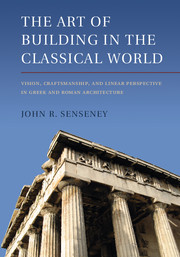 The Art of Building in the Classical World
The Art of Building in the Classical World Book contents
- Frontmatter
- Contents
- List of Figures
- Preface
- Note on Dates and Translations
- Abbreviations
- INTRODUCTION: CHALLENGES OF ANALYSIS AND INTERPRETATION
- 1 THE IDEAS OF ARCHITECTURE
- 2 VISION AND SPATIAL REPRESENTATION
- 3 THE GENESIS OF SCALE DRAWING AND LINEAR PERSPECTIVE
- 4 ARCHITECTURAL VISION
- Excursus: Envisioning Cosmic Mechanism in Plato and Vitruvius
- Appendix A Analysis of the Dimensions of the Blueprint for Entasis at Didyma
- Appendix B Analysis of the Hypothetical Working Drawing for Platform Curvature at Segesta
- Appendix C Analysis of the Hypothetical Working Drawing for Platform Curvature in the Parthenon
- Notes
- References
- Index
Excursus: Envisioning Cosmic Mechanism in Plato and Vitruvius
Published online by Cambridge University Press: 07 October 2011
- Frontmatter
- Contents
- List of Figures
- Preface
- Note on Dates and Translations
- Abbreviations
- INTRODUCTION: CHALLENGES OF ANALYSIS AND INTERPRETATION
- 1 THE IDEAS OF ARCHITECTURE
- 2 VISION AND SPATIAL REPRESENTATION
- 3 THE GENESIS OF SCALE DRAWING AND LINEAR PERSPECTIVE
- 4 ARCHITECTURAL VISION
- Excursus: Envisioning Cosmic Mechanism in Plato and Vitruvius
- Appendix A Analysis of the Dimensions of the Blueprint for Entasis at Didyma
- Appendix B Analysis of the Hypothetical Working Drawing for Platform Curvature at Segesta
- Appendix C Analysis of the Hypothetical Working Drawing for Platform Curvature in the Parthenon
- Notes
- References
- Index
Summary
The following is an excursus on Plato, Vitruvius, and preceding traditions of thought and craftsmanship going back to Anaximander and architects of the Archaic period. In addressing possible alternative justifications for the existence of ichnography before the Late Classical period, the analysis here supplements the exploration of buildings in Chapter 1. In setting buildings aside for philosophical texts and architectural theory, one may thoroughly enter into the premise at hand: That an interest in drawing among educated architects as intellectuals might have arisen in a literary background from abstract thought, and not just the practical requirements of planning. Along with a subsequent return to visual material in Chapter 2, this evaluation will elicit a nuanced view of connections between craftsmanship, intellectual traditions, and the production of knowledge in the Classical period. As the chapters of the main text elaborate, the genesis of ichnography, linear perspective, and characteristically Greek understandings of order in nature appear to owe a great deal to the design process of Greek architects in the craft of building, particularly in regards to the role of drawing in the creation of individual features at 1:1 scale that preceded reduced-scale drawing.
In carefully examining texts, furthermore, an encounter with additional concerns expressed in intellectual traditions changes the nature of questions asked in relation to the material evidence. Like the ideai that embody the principles of which architectura consists for Vitruvius, for Plato they connect unexpectedly to vision and the related graphic role of nature through representations of cosmic mechanism.
- Type
- Chapter
- Information
- The Art of Building in the Classical WorldVision, Craftsmanship, and Linear Perspective in Greek and Roman Architecture, pp. 175 - 188Publisher: Cambridge University PressPrint publication year: 2011


